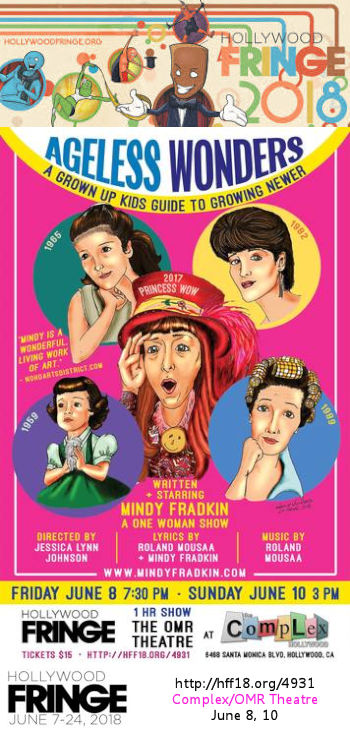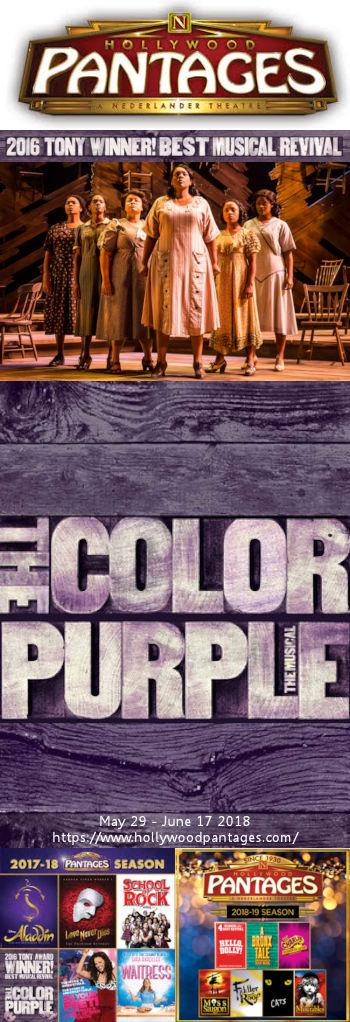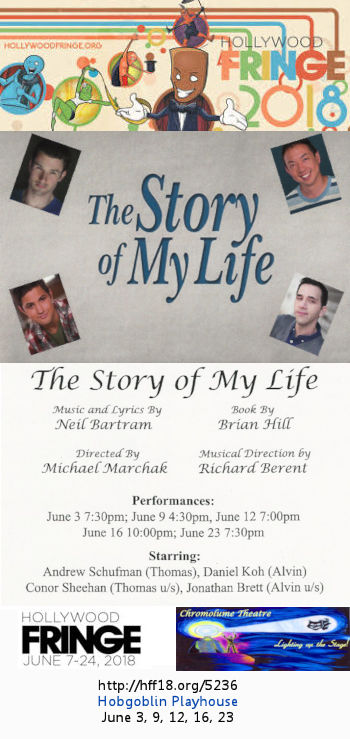 As I wrote about our Saturday shows, the reaction of audiences to theatre can range the gamut from “Wow! What was that!” to “Ugh. What was that?”. Saturday had the “Wows”. Sunday was different: there was a “Hmmm” and an “Ugh”. But first, however, my stock description of what the Fringe Festival is:
As I wrote about our Saturday shows, the reaction of audiences to theatre can range the gamut from “Wow! What was that!” to “Ugh. What was that?”. Saturday had the “Wows”. Sunday was different: there was a “Hmmm” and an “Ugh”. But first, however, my stock description of what the Fringe Festival is:
* For those unfamiliar with Hollywood Fringe Festival (FB), there are over 390 different shows occurring in the heart of Hollywood, with most along the stretch of Santa Monica Blvd from Western to W of LaBrea, and between Hollywood Blvd and Melrose. The shows run from 5 minutes to 2 hours, from one person shows to gigantic casts, from mimes to musicals. They have one — and only one — thing in common: they have to be able to load into a theatre in 15 minutes or less, and get out afterwards in the same time. You never know what you will see: it could be complete crap, it could be the start of a major new show. The shows and scheduling thereof are a nightmare to coordinate, but you could easily end up seeing four to five shows in a day. However, you can be guaranteed of a good time.
And now, on to our Sunday shows:
 As we were reading through the Fringe schedule back in May to decide what shows we should see, we came across the following description for How to Be Lazy and Not Feel Guilty:
As we were reading through the Fringe schedule back in May to decide what shows we should see, we came across the following description for How to Be Lazy and Not Feel Guilty:
A hilarious social satire about a woman who overworks herself until she goes mad! …yay?
Follow Jenine and a psychotic ensemble of characters – including her boss, family, Sponsors™, Satan and coworkers – as they collectively run her into the ground! Watch her sacrifice everything for her ambition: her time, her health… maybe even… her relationship?! To find out if she makes it out alive or is completely consumed by the pressures of productivity, you’ll have to watch for yourself. An absurdist, style-bending, ensemble-based satire guaranteed to make you take a long hard look at your own life – what more could you want?
Being the types that want to be lazy, and being Jewish so we understand guilt, this sounded like the perfect show.
As the summary indicated, the story presented centered around Janine, an employee at some generic company where, presumably, she did critical but generic things. The company was pressuring her to get these generic things — and creating loads of guilt around her getting these things done. There was so much pressure, in fact, that she was giving up other things in her life: sleep, her boyfriend, sleep, sex, sleep, friendships. Did I mention that she was working so hard she was constantly fighting not to fall asleep, and feeling even more guilty when she did.
The execution of the show was humorous and frenetic, silly and overdone at times, earnest at others. What impressed me most about the show was the point that it was making: that far too often we place far too much importance in the things that we have to do, as opposed to the people we care about around us. That’s a message that resonates with someone who is going crazy doing updates to the Highway pages, attempting to attend 20 HFF18 shows and write up every one, doing stuff for my synagogue’s Men’s Club, all without ignoring my wife who has criticized me before for spending too much time on the computer.
Translation: Yes, this show hit home. Yes, this show incited some deep thought and internal conversations. Yes, this show did exactly what theatre should do.
The execution of the show wasn’t perfect. It was Fringe, after all. It was a bit overdone, the freneticism distracted at times from the story. If it is to move and expand into a longer piece with a longer life for traditional venues, it needs expansion, deeper fleshing out of the characters and relationships, and better understanding of the drives and changes. It also needs to show stronger motivation, and perhaps some false starts at moving in the right direction. But I think the notion and underlying message would make that effort worth it: this show says something that needs to be said.
As Janine, Sarah Richards (FB) captured the overworked and overwhelmed nature of her character well. She was fun to watch. Duncan Kinzie (FB) was her boyfriend Thomas, and he embodied an interesting character contrast. The remaining actors (Emerson Harris (FB), Drew Petriello (FB), and Addison Turner (FB)) formed an ensemble of various characters: bosses, parents, co-workers, the Devil, and such. I do have to complement Addison Turner (FB), just because she was just so much fun to watch, with a great energy and humor that radiated to the audience.
The show was written by Drew Petriello (FB), and directed by Natasha Gualy (★FB, FB) [who was also the producer, and “designer of all things”]. Sound design by Emerson Harris (FB). It was a Leaky Faucet & Sons (FB) production.
In summary, I think How To Be Lazy and Not Feel Guilty was worth seeing.
 Alas, I can’t say the same thing for Ageless Wonders: A Grown Up Kids Guide to Growing Newer. It fell into the “Ugh. What was that?” category, and did not meet our expectations.
Alas, I can’t say the same thing for Ageless Wonders: A Grown Up Kids Guide to Growing Newer. It fell into the “Ugh. What was that?” category, and did not meet our expectations.
The show was described on the Fringe website as:
Mindy is fascinating. All she has to do is get up and talk. She muses on entering this new “senior club” and enlightens on the benefits ( and discounts!). Fradkin aka Princess Wow gives a fresh perspective on aging and that we truly are “ageless wonders”. She speaks directly to the audience, takes you into her world, and you gladly go. This one hour performance promises to evoke some tears, guarantee smiles and even laughter. The play has a catchy original score written by Grammy Award winner Roland Mousaa & Mindy Fradkin, both of whom had the privilege of working and befriending the late great Pete Seeger, folk icon/activist.
We went in expecting to have a one-person exploration of the aspects of aging, and how one can age without gaining the “Get Off My Lawn” attitude. We expected a performer that had the material down pat, that was able to engage and tell the story and keep the audience entranced. That view would be reinforced by all the rave reviews on the performers website. One would expect a highly entertaining, well-organized, one-person show.
I don’t know what show those people were seeing (or what they were smoking). Perhaps she was having a bad day, but what we got was something different. What we got was the author, Mindy Fradkin (FB), also known as “Princess Wow“, rambling and telling the story of her life, constantly putting on her glasses and reading from her notes, and then taking them off again. Incidents were told multiple times. There was disorganization on the slides shown, and they often didn’t seem to convey anything useful. It came across as a self-indulgent rental of a theatre space.
Here’s another way of looking at it: I’m not an actor. I’m a cybersecurity expert, and I often get up and give talks and tutorials using Powerpoint. I know my material down pat — not as a script, but I intimately know the subject. I use my Powerpoint slides as a reference, just as an actor would use a prompt. I can do an engaging talk and finish on time. But I’ve been in many a presentation where the presenter just reads off their slides, and it is a painful process. This show struck me as the latter.
The nature of the show was reflected in the program that was handed out. Not only does it have bios of the actors, authors, and production team, but there are detailed photo credits and graphic credits, details on the video editing, links of referrals from the Powerpoint slides, links of additional resources, book references, and links to other references. Perhaps we should have received a copy of the slides.
I could have done better just giving my tutorial on the Cybersecurity Acquisition Process. Perhaps at the next Fringe. 🙂 But that’s the subject of tomorrow’s post.*
(*: The link will work, well, tomorrow)
I think the show oversold itself, and needed significantly better preparation. I expect a Fringe show, unless advertised otherwise, to be “off book”. If you must have a trigger, put it on the Powerpoint slide, have your laptop screen facing you, and keep your eyes on the audience (except for the occasional quick glance). Don’t keep looking in your book of notes. Most important: know your material, know what you want to say, and clearly make the points you want to make. Don’t ramble.
The production was directed by Jessica Lynn Johnson (FB), who seemed to be directing a large number of other Fringe shows as well. Jessica: Please get your performer to listen to you and learn her material; I’m sure you tried. It featured a few songs — with questionable singing — with lyrics by Roland Mousaa (FB) and Mindy Fradkin (FB) (Roland & Mindy FB), and music by Roland Mousaa (FB).
Luckily, the listed performances have all taken place, although I seem to recall mention of a performance being added. Avoid it. This has evidently been submitted to other Fringe festivals; I’d wait for word of mouth to see if she was better prepared and had improved the show before trying it again. We weren’t that impressed.
***
Ob. Disclaimer: I am not a trained theatre (or music) critic; I am, however, a regular theatre and music audience member. I’ve been attending live theatre and concerts in Los Angeles since 1972; I’ve been writing up my thoughts on theatre (and the shows I see) since 2004. I do not have theatre training (I’m a computer security specialist), but have learned a lot about theatre over my many years of attending theatre and talking to talented professionals. I pay for all my tickets unless otherwise noted. I am not compensated by anyone for doing these writeups in any way, shape, or form. I currently subscribe at 5 Star Theatricals (FB) [the company formerly known as Cabrillo Music Theatre (FB)], the Hollywood Pantages (FB), Actors Co-op (FB), the Chromolume Theatre (FB) ז״ל, a mini-subscription at the Soraya [nee the Valley Performing Arts Center (VPAC)] (FB), and the Ahmanson Theatre (FB). Through my theatre attendance I have made friends with cast, crew, and producers, but I do strive to not let those relationships color my writing (with one exception: when writing up children’s production, I focus on the positive — one gains nothing except bad karma by raking a child over the coals). I believe in telling you about the shows I see to help you form your opinion; it is up to you to determine the weight you give my writeups.
Upcoming Shows:
It’s June — ah, June. That, my friends, means only one thing: the Hollywood Fringe Festival (FB), Here’s our June schedule:
- ✔ Friday, June 1: 8:00pm Family Schmamily (Eclectic Company Theatre (FB)) [which, alas, is closing]
- ✔ Saturday, June 2: 1:30pm 19 Years Later: A Harry Potter Parody (Hobgoblin); 4pm From Toilet to TInseltown(Hobgoblin); 8pm Billy Porter: The Soul of Richard Rodgers at the Soraya [nee the Valley Performing Arts Center (VPAC)].
- ✔ Sunday, June 3: 4:00pm Ingersoll Speaks: Again (Studio C); 6:00pm The Universe (101) (Complex/Dorie).
- ✔ Thursday, June 7: 8:30pm They’ll Be Some Changes Made Today (Hobgoblin)
- ✔ Saturday, June 9: 4:30pm The Story of My Life (Hobgoblin); 8:00pm The Color Purple (Hollywood Pantages (FB))
- ✔ Sunday, June 10: 1:30pm How To Be Lazy and Not Feel Guilty (Complex/OMR); 3:00pm Ageless Wonders: A Grown-Up Kids Guide to Growing Newer (Complex/OMR)
- Friday, June 15: 6:00pm Shabbabaque at TAS
- Saturday, June 16: 2:00pm Trojan Woman (Lounge/1); 3:45pm Pain in my Aspergers (Lounge/2)
- Sunday, June 17: 1:00pm Earhart: More Than A F-ing Mystery (McCadden); 2:30pm Attack of the Retro Sci-Fi Futurist (Complex/Ruby); 430p Amanda The Barbarian (Complex/Dorie); 7pm The Bitch is Back: An Elton John Cabaret (Three Clubs)
- Saturday, June 23 (me only): 2:00pm Mime Time (Complex/Ruby); 4pm Cowboy Mouth (Actors Company/Little Theatre); 530pm Monday Morning/Cheese & Things (Actors Company/Little Theatre); 800p Meanwhile, Back at the Super Lair (New American Theatre)
- Sunday, June 24 (me only): 3:00pm A Reasonable Fear of Tubas (Actors Company/Let Live); 4:00pm Beatniks (Actors Company/Let Live); 7:00pm Sweet Charity (Reprise/UCLA (FB))
July will get busier again. It starts with the 50th Anniversary of Gindling Hilltop Camp, followed by On Your Feet at the Hollywood Pantages (FB). For the next weekend, as Jane Eyre The Musical from Chromolume Theatre (FB) looks to be a dead parrot ⚰🐦., we’ve replaced it with Tabletop, a reading of a new musical about tabletop RPGs at the Charles Stewart Howard Playhouse (FB). The third weekend in July brings a Bat Mitzvah in Victorville, and Beauty and The Beast at 5 Star Theatricals (FB) that evening on Saturday, and a hold for the OperaWorks (FB) “Opera ReConstructed” at CSUN on Sunday. The last weekend may be a Muse/ique (FB) show. August starts with Waitress at the Hollywood Pantages (FB) on Saturday, and the Actors Co-Op Too! production of Always Andrews: A Musical Tribute to the Andrews Sisters on Sunday at Actors Co-op (FB). The next weekend brings the last Actors Co-Op Too! production, Twelfth Night, or What You Will at Actors Co-op (FB). There may also be a production of The Most Happy Fella at MTW — I’m not sure about it, but the hold date is on the calendar.
As always, I’m keeping my eyes open for interesting productions mentioned on sites such as Better-Lemons, Musicals in LA, @ This Stage, Footlights, as well as productions I see on Goldstar, LA Stage Tix, Plays411 or that are sent to me by publicists or the venues themselves. Note: Lastly, want to know how to attend lots of live stuff affordably? Take a look at my post on How to attend Live Theatre on a Budget.
 What is the purpose of school? An article today from NPR on the fading away of “Home Ec” classes, combined with another article about LA Unified establishing the goal of preparing every grad for CSU or UC, got me thinking: Should we be preparing students for college, or for life? I think both, m’self.
What is the purpose of school? An article today from NPR on the fading away of “Home Ec” classes, combined with another article about LA Unified establishing the goal of preparing every grad for CSU or UC, got me thinking: Should we be preparing students for college, or for life? I think both, m’self.

 The news today is filled with discussions around
The news today is filled with discussions around 

 Recently, after one of the numerous Fringe shows we’ve seen, I was talking to my wife. I opined that if I ever put on a Fringe show, it would likely me getting up and doing a short tutorial on the NIST Risk Management Framework using Powerpoint slides, and it would probably land with a thud. My wife, however, thought that with the right director, it could work…
Recently, after one of the numerous Fringe shows we’ve seen, I was talking to my wife. I opined that if I ever put on a Fringe show, it would likely me getting up and doing a short tutorial on the NIST Risk Management Framework using Powerpoint slides, and it would probably land with a thud. My wife, however, thought that with the right director, it could work…


 Saturday was a musical day, and a day for deconstruction. We started down the street from the
Saturday was a musical day, and a day for deconstruction. We started down the street from the  President Trump has just met with the leader of North Korea, and we need to be very very careful and be cautious…
President Trump has just met with the leader of North Korea, and we need to be very very careful and be cautious…

